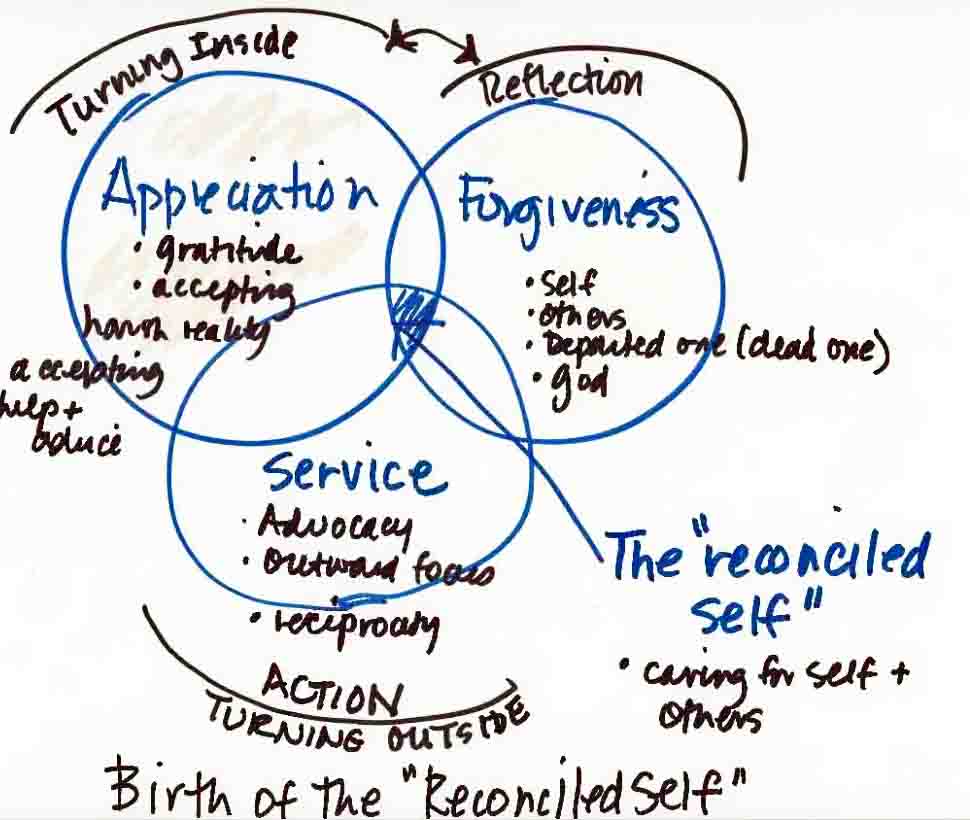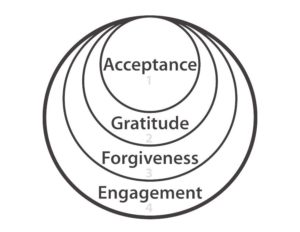The relationships between the four Gateways of Wisdom
The illustrations below show how Karl and I conceptualize the relationships between and among the four Gateways of Wisdom in Chapters 7 through 10: Acceptance, Gratitude, Forgiveness, and Engagement.
My first sketch of our healing model looks like this:

The final version, illustrated by my friend Brendan Hurley, looks this:

The Reconciled Self:
Integrating Acceptance, Gratitude and Forgiveness to Allow Engagement
In our healing model are four nested Gateways of Wisdom. Three are nested within the broader realm of Engagement because, when we engage with others, we invariably do it “in community”. And, ultimately, being in a community is invaluable to the grieving person. Everyone needs support in this sacred work. However, we will gain little value from merely passing through a Gateway unless we commit to follow some form of healing direction. At heart, we undertake our healing journey to deepen our experience. So, we need to try to do some things differently.
The four Gateways are milestones — or touchstones — in the landscape of the life of a grieving person. They could also be called portals. We can be reassured that, while we may journey through a geography of uncertainty for some time in our grief, the four Gateways always stand on solid ground. Thus, we can safely linger there, knowing that that ground will not shift under us. For example, when we dwell in the Forgiveness realm, we can be confident that we are safe there and that our healing intentions — however shy, inexplicit or latent — will be honored and supported there.
FOLLOWING RUDOLF STEINER’S ADVICE about staying connected to a loved one who has died
As it appears to me that Rudolf Steiner was a precise man, I follow his advice closely, adding my own touches refined after nearly two years of communicating with Karl. I learn that, while we must undertake this sacred work of a healing journey with clarity of intent, the process is meant to be accepting, generous, forgiving, and healing. Feeling gentleness, lightness, love, and grace as we reconnect with our loved one will nourish us, lend us stability, and support our sacred purpose.

Ten qualities of a RECONCILED SELF
As we engage in the process of journeying toward the reality of a Reconciled Self, we will probably exhibit some or all of these 10 qualities (described by Alan Wolfelt):
- FINALITY: An ability to acknowledge the reality of either the death or our loss fully;
- ACCEPTING PAIN: An acknowledgment that pain and grief are necessary parts of life;
- SOFTENING: A reduced frequency of intense pangs of grief;
- ABSTRACT BONDS: A changing relationship with the one who has died — from one of presence to one of memory;
- THE DIMENSIONS OF GRIEF: An acknowledgment of the spiritual and emotional aspects of grief (not primarily the intellectual ones);
- ENERGY AND CONFIDENCE: A renewed sense of energy and confidence;
- MEANING AND PURPOSE: A renewed sense of meaning and purpose;
- RE-INVOLVEMENT: A capacity to become re-involved in the activities of living;
- HOPEFULNESS: A hope for a continued life emerging through subtle changes and small advancements; and
- THE NEW NORMAL: The discovery of a “new normal”: we have come a long way, and to some extent, we have arrived (adapted from Wolfelt, J., “Touchstone Nine: Seeking Reconciliation, Not Resolution,” in The Wilderness of Grief, 2007: 91-98).
a kind of negotiation strategy
Robert Enright calls this process “a kind of negotiation strategy”, requiring us to build our “forgiveness muscles.” Forgiveness is the key to finding meaning and finding meaning is key to reconciliation. Reconciliation is not resolution. It’s mostly about acceptance and restoring harmony when something has set us apart. Courage, hopefulness, and goodwill serve us well in this delicate endeavor.
Illustration credit with much gratitude: Brendan Hurley, 2018.
